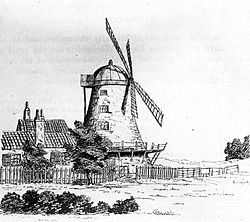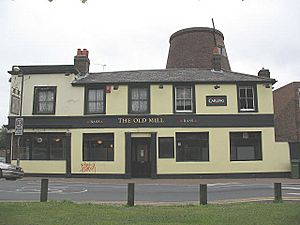Plumstead Common Windmill facts for kids
Quick facts for kids Plumstead Common Windmill |
|
|---|---|

Drawing dated 1820
|
|
| Origin | |
| Grid reference | TQ 4480 7791 |
| Coordinates | 51°28′54″N 0°05′02″E / 51.4817°N 0.0840°E |
| Year built | Early nineteenth century |
| Information | |
| Purpose | Corn mill |
| Type | Tower mill |
| Storeys | Four storeys |
| No. of sails | Four |
| Type of sails | Common sails |
| Winding | Hand winded |
Plumstead Common Windmill is an old tower mill located in Plumstead Common, which is part of the Royal Borough of Greenwich in south London. This historic windmill once helped grind corn for the local community.
Contents
What is Plumstead Common Windmill?
A windmill is a building that uses the power of the wind to turn large blades, which then power machinery inside. Plumstead Common Windmill is a specific type called a tower mill. This means it has a tall, round stone or brick tower. Inside, it used to have machinery to grind corn into flour.
A Look Back: History of the Windmill
When Was the Windmill Built?
The Plumstead Common Windmill first appeared on maps between 1819 and 1843. This tells us it was built sometime in the early 1800s. It was an important building for the area, helping to process food.
What Happened at the Mill?
In 1827, something interesting happened at the mill. Many people gathered on a platform to watch a pretend battle. The platform broke under the weight, and some people got minor injuries.
Later, the windmill stopped being used for grinding corn. By 1848, it was changed into a brewhouse, which is a place where beer is made.
The Mill Today
Today, the tall brick tower of the Plumstead Common Windmill is still standing. It is now part of a building called the Old Mill pub. So, while it no longer grinds corn, its history lives on as part of a local landmark.
How the Windmill Looked
The Plumstead Common Windmill had a four-storey brick tower. It had four large sails that caught the wind. These were known as "common sails."
There was also a platform, or "stage," on the first floor. The top of the mill, called the "cap," was shaped like a dome. Workers had to turn this cap by hand to make sure the sails faced the wind.


